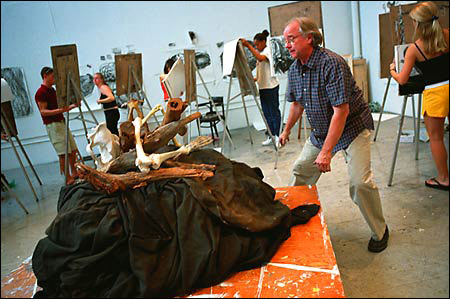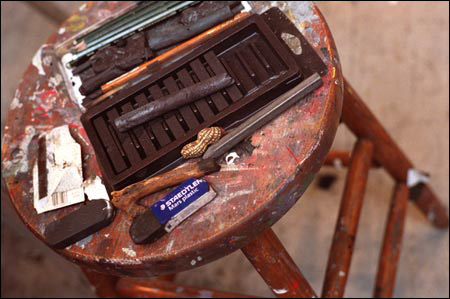Drawing on all your resources to explore the nature of drawing:
Classes challenge students to look inward as well as outward

If your goal is to go home with a nice picture of an earthenware pitcher and a bowl of apples that you can frame and give to your Aunt Ida, better go somewhere else. Here it’s all about process, not product.
“What we’re tying to do is make it exploratory, investigatory, keeping things as open as possible rather than creating fixed products that can be closed down and dead,” says Bert Yarborough, who is teaching two Summer School courses – “Exploring the Nature of Drawing” and “Drawing into Painting.”
It’s an immersion experience – eight weeks of covering paper and canvas with lines, shapes, and color, sometimes so quickly that there’s no time to think about what you’re doing – and that’s a good thing.

“I get them to do quick gesture drawings where they just try to capture the essence of the thing. When they’re working fast, they’re not thinking. Thinking generally kills the work. They’ve got the rest of their lives to think.”
There are opportunities to work slowly and thoughtfully too. In the “Drawing into Painting” class, students were standing around a pile of objects whose incongruity might have pleased Salvador Dali: a stuffed wolf, a cow’s skull, a teddy bear, assorted bones and branches. Each of the students focused on a few items from this melange, some rendering them in broad, fuzzy strokes, others more meticulously.
“Some people are going to work more deliberately. I don’t want them to all work the same way. You can always go back to the way you used to work, but what this class can do is broaden your vocabulary.”
The linguistic analogy is an apt one. In fact, Yarborough’s students seem to be learning a whole new language, and just as in the process of learning to communicate in French, Japanese, or Arabic, the most important thing is to leap in fearlessly without worrying that you may sound like a nitwit.
“I try to keep them poised on the edge of failure as much as possible. Failure and risk taking are the biggest parts of this experience. Frustration can be a good thing. It can help fuel creativity.”
Come to think of it, Aunt Ida just might enjoy having a memento from one of Yarborough’s classes – but she’d probably be more impressed by the parts that couldn’t be put inside a frame.





